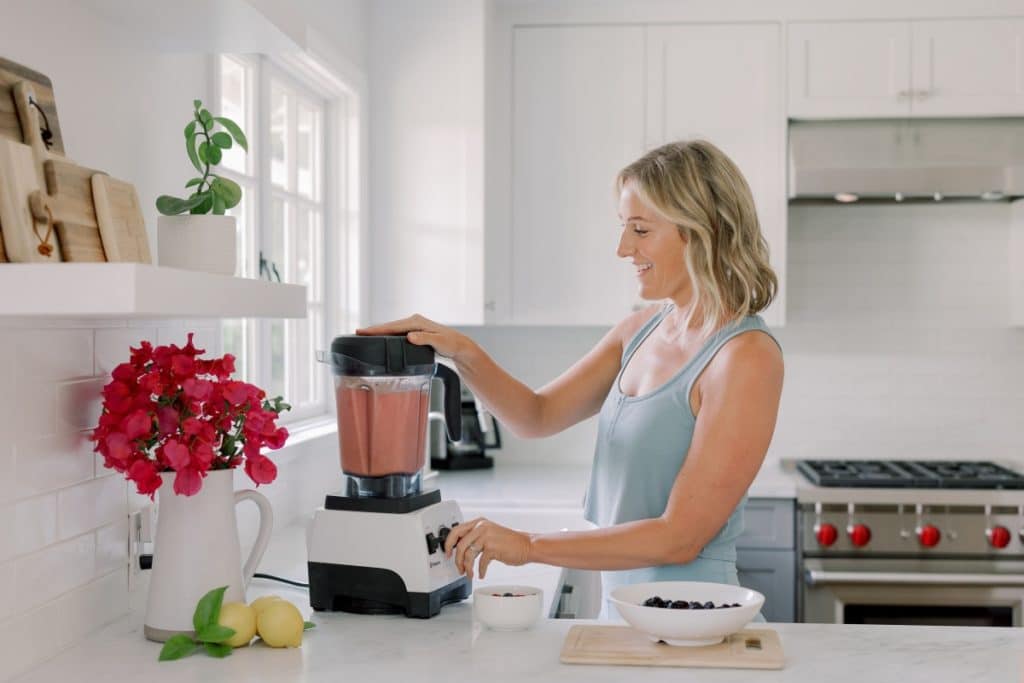
The idea of eating detoxifying foods might feel like a fad. It’s often linked to trendy teas, shakes, powders, herbs, juices, or supplements that claim to remove all the toxins from your bloodstream in a “miraculously” short amount of time.
Although it’s been co-opted as a marketing tactic by the diet industry, as a nutrition therapist myself, I can tell you that the process of detoxification offers many health benefits. (And no, you don’t need to be an expert to know how reap those benefits.)
I want to cut through all the buzz and hype and get right into what we all need to know about eating detoxifying foods. Plus, we’ll talk about how a few simple swaps can have a significant impact on your health and well-being (hint: you don’t need an entire “detox diet” or “expensive juice cleanse” to reap the benefits).
As a disclaimer, I want to emphasize that no foods are inherently evil—food is fuel; we need it for energy, alertness, endurance, strength, and wellness. Some foods have more nutritional density than others, but all foods are permissible and can be part of a balanced and joyful lifestyle. Listen to your body and your own specific needs, then make dietary choices that feel nourishing to you.

Managing Toxins in Today’s World
There are thousands of toxic chemicals in the products we use, the clothes we wear, the foods we eat, and even the environment around us. Many of us are exposed to these chemicals on a daily basis, which can lead to major health concerns over time.
According to the Environmental Protection Agency, here are a few ways that toxins impact many aspects of our health, including:
- Compromised immune function
- Hormonal imbalances
- Increased cholesterol levels
- Reproductive or fertility issues
- Hypertension in pregnant women
- Elevated risk of cancer
It’s crucial to be aware that pesticides, antibiotics, preservatives, and artificial ingredients that are in many of the mass-market brands and processed food in grocery store aisles. However, while these chemicals can increase the toxic load in our systems, we don’t have to give them up altogether.
The beautiful thing is that our bodies were designed with the ability to detoxify. It’s incredible. We have detoxification pathways that move toxins through our body to protect our health. The problem comes when either our detoxification pathways aren’t working as they should (they’re sluggish) or our toxic load gets so high that our body’s innate detoxification pathways can’t keep up.
This is why the goal is to balance and bring other foods into your diet to minimize the impact of these toxins and support our body’s natural detox pathways.
How Detoxing Foods Help
Detoxifying foods help your liver utilize GST enzymes, which are responsible for flushing out the harmful chemicals we take in. This lowers oxidative stress to protect us from chronic illness, bolster our various organ functions, and even sharpen our brain health. In short: nutrition cleanses us naturally from the inside out.
When you work some of the foods I share below into your diet, you can reduce your risk of:
- Chronic inflammation
- Reproductive issues
- Cardiovascular problems
- Immune dysfunction
- Cognitive impairment
The Best Foods for Detoxification and Their Benefits
The first thing to know is that products in the grocery store promoted as “detox food” or the newest fad detox supplement are not what we’re looking for. To reap the physical and mental health benefits of detoxifying foods, choose whole foods that are high in antioxidants. (I get into some great examples of these foods in a minute—don’t worry, I’ve got you covered!)
These organic compounds neutralize free radical molecules (which occur due to chemical exposure and cause damage to the cells), so you can metabolize and eliminate those toxins.
Many antioxidant-rich foods also contain probiotics, fiber, and omega-3 fatty acids, which can aid in healthy digestion and contribute to a diverse gut microbiome. Here is a wide range of detoxifying foods to add to your grocery list.
Cruciferous Vegetables
Brussels sprouts, cabbage, radishes, broccoli, cauliflower, and leafy greens will help your liver create a protein called glutathione, which it uses to excrete harmful chemicals. These cruciferous vegetables also contain many vitamins, minerals, and bioactive metabolites that can protect against cancer.
Try our Kale and Brussel Sprout Salad recipe.
Nuts and Seeds
Almonds, walnuts, flax, hemp, sesame, chia, and sunflower seeds can lower your risk of diabetes, stroke, infections, heart issues, metabolic syndrome, cancer, and all-cause mortality. These benefits are due to their protein, fiber, antimicrobial, and antioxidant profile, which helps manage the effects of inflammation.
Try our Homemade Nutty Granola recipe.
Fermented or Cultured Foods
Kimchi, yogurt, sauerkraut, miso, tofu, kefir, seaweed, or pickled vegetables contain healthy bacteria (including probiotics) that will cleanse and improve your gut microbiota. The fermentation process also releases organic molecules to promote intestinal health, lower cholesterol, and boost immunity.
Try our Veggie Packed Kimchi Rice recipe.
Allium Vegetables
Ginger, onions, chives, shallots, garlic, leeks, and turmeric have a high concentration of antioxidants to help lower inflammation, oxidative stress, blood pressure, and metabolic dysfunction. The sulfur content in many allium vegetables has also been found to treat the effects of toxic heavy metal absorption.
Try our Grain-Free Ginger Collagen muffins recipe.
Berries and Citrus Fruits
Grapefruits, lemons, oranges, limes, and all types of berries contain a wide range of antioxidants (ex. phenolic acid, luteolin, flavanone, anthocyanin, chalcone, etc.). These nutrients combat the free radicals known to cause tissue damage, viral or bacterial infections, and cancer or other chronic diseases.
Try our Orange Flax Smoothie recipe.
Foods with Natural Oils
We’re all about the healthy fat here at Lindywell because of the goodness it provides our minds and bodies. Avocados, soybeans, mackerel, sardines, tuna, salmon, and pasture-raised eggs contain omega-3 fatty acids from natural oils, which act as a line of defense against cadmium exposure. This heavy metal can harm your immune function, musculoskeletal growth, nervous system, and vital organs. However, omega-3 fatty acids will form a protective barrier around your cells to decrease absorption.
Try our Avocado Egg Bake with Salsa recipe.
Nourishing and Detoxifying Recipes for Each Meal
Choosing detoxifying foods isn’t just about supporting liver health, boosting your immune system or toxin elimination—though those are all great benefits! The foods you consume can also help cultivate radical self-love, nourishment, and balance. Not only will optimal nutrition make you feel more energetic, and vibrant—but it can also promote mindful, intuitive eating habits that help to heal your relationship with food.
So, what does it look like to bring this all together? Here’s a little cheat sheet to create some tasty meals each week!
Breakfasts:
- Mango & Coconut Chia Pudding
- Avocado & Salsa Toast with Sauerkraut
- Ginger Apple Green Smoothie
- Almond Berry Muffins
Lunches:
- Parsley & Lemon Mixed Quinoa Salad Bowl
- Buffalo Cauliflower Salad
- Sprouts & Squash Salad
- Salmon & Greens Pasta with Lemon Dressing
Dinners:
- Chickpea Spinach Curry with Cucumber-Yogurt Sauce
- Chicken Chili Stew
- Citrus, Kale + Avocado Salad
- Miso, Chicken and Green Onion Soup
Snacks and Desserts:
- Lemon Poppyseed Oat Bites
- Maple Chili Roasted Nuts
- Trail Mix Superfood Cookies
- Anti-inflammatory Wildberry Parfait
Beyond Nutrition: Other Holistic Detox Practices
Eating nutrient-rich foods is just one way to stimulate the body’s natural detoxification process. Now let’s turn our attention to a couple of other holistic wellness practices that you can work into your routine—alongside nutrition—for balance, cleansing, and renewal.
Optimal Hydration: There’s a direct correlation between high water intake and a lower risk of all-cause mortality. That’s because optimal hydration activates the liver enzymes to flush out waste products, carcinogens, and other harmful toxins while promoting healthy nutrient digestion and absorption. Most people need about half their body weight in ounces – and possibly more depending on how rich your diet is in fruits and vegetables, weather, activity level, phase of menstrual cycle, and other factors that impact water intake and needs.
Physical Activities: Regular movement helps open your detoxification pathways and in turn, decreases inflammation. This lowers oxidative stress so your cells can purge excess liver build-up more efficiently. If you struggle to make time for movement, start your 14-day free trial of Lindywell to get instant access to 350+ on-demand Pilates classes.
Nourish and Flourish with the Lindywell Community
Ready to embrace a deep sense of renewal from the inside out and support your overall health, both mind and body? Bring some detoxifying foods into your diet and join us here at Lindywell. Our online community will empower you with the tools to nourish your mental and physical wellness so you can flourish in all areas of life.
Sign up now to get 14 days free and access more than 350 gentle Pilates sessions, breathwork practices, and nutritious meal plans to cultivate a healthy, non-toxic relationship with yourself!
Disclaimer: This information should not replace the recommendations of a medical professional or registered dietitian, please note changing diet alone is not guaranteed to resolve the health concerns listed so always please contact your medical professional about your specific needs.








10 thoughts on “Cleansing from the Inside Out: Top Detoxifying Foods for Renewal”
I love that you make wellness a part of your daily life choices. Eating well and exercising are great ways to accomplish this. But so you have some quick easy choices for lunches on the run? Most of us are so busy that it is difficult to make one healthy meal, let alone three. How can we make it easier? Thank you for sharing all of your nutrition knowledge with us!!
We would encourage you to check out the lunch options in your recipes by clicking on the three lines at the top right of the page to filter the recipes.
Quick Prep Sweet Potato & Chicken Winter Salad might be a good one to try!
Very nice article – good job!
Some of the recipes in your checklist sound yummy. I tried to find them in the app and could not. Especially the Slow-roasted salmon with fennel and citrus, and the Ginger and Tumeric cookies.
What am I doing wrong?
Thanks for your comment, Deborah, and for letting us know! While the checklist was meant to be an inspiration for your meal planning, our team is working on updating the blog to correct for this. In the meantime, here are a few awesome recipes you could try:
Grilled Salmon and Lemons
Lemon + Scallion Salmon
Trail Mix Superfood Seed Cookies
I follow vegan diet, any thoughts on that?
We think there is a lot of overlap between detoxifying foods and a vegan diet. We encourage everyone to check with their healthcare professional to get individualized recommendations to meet their unique needs and to listen to their bodies and do what is best for them.
Is there a recipe book I can purchase??
Great question! While we don’t have a recipe book for purchase, Lindywell members have access to over 650 quick and nutritious recipes with the Lindywell membership! We’d love to invite you to give Lindywell another try with a FREE, 14-day trial! Click here for more info!
Yes I would like to try and improve my overall health
We would love to invite you to give Lindywell a try with a FREE, 14-day trial. Click here to check it out and feel free to reach out to the Lindywell Care Team at [email protected] with any questions! We’re here to support you!